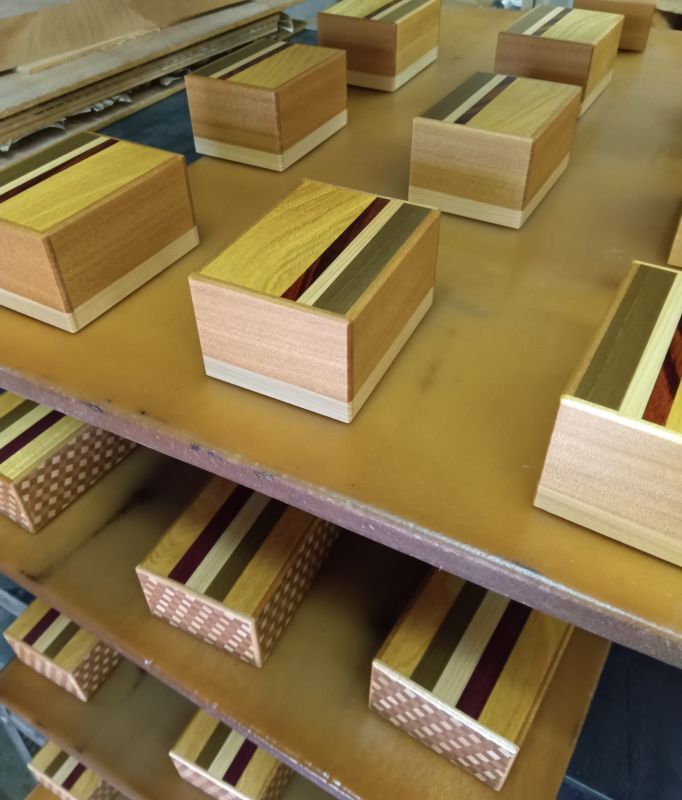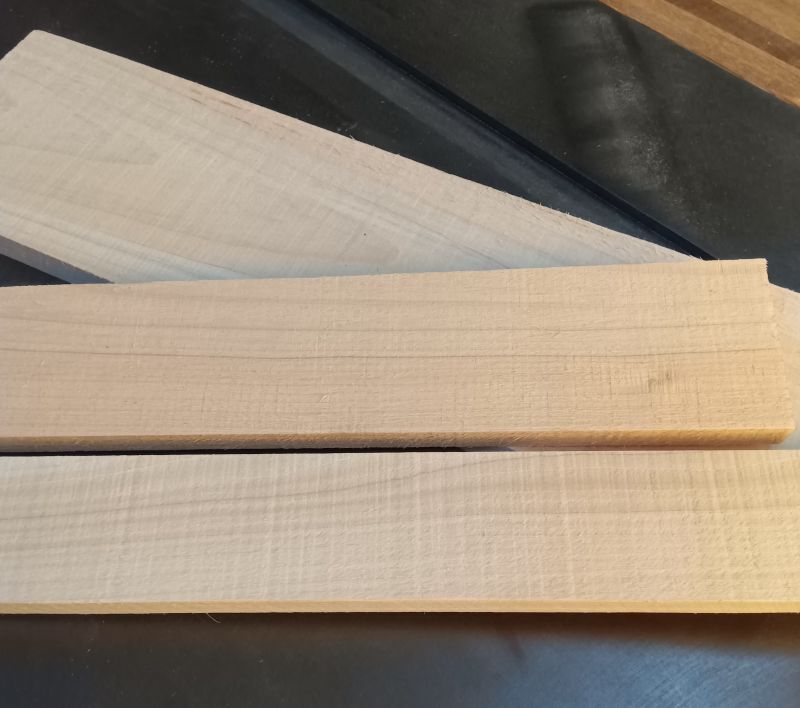Hinoki wood
A typhoon No.7 (the 7th Typhoon of the season) is approaching our area tomorrow, so today is extremely hot. It usually gets very hot before and after a typhoon. Tomorrow, in addition to the wind and rain, the humidity will be very high as well. Therefore, I plan to finish shipping tasks early today and will not do any shipping work tomorrow. Sometimes, the delivery companies also stop operating due to the impact of the typhoon.
High humidity has a significant impact on puzzle box-making as well. The structural parts of the puzzle box absorb moisture, so it’s best to avoid such work tomorrow. After the typhoon, the absorbed moisture will be released, causing warping and distortion of the wood parts. Therefore, I have prepared boards to work on tomorrow, where I will be attaching Yosegi-sheet to the boards. This time, I plan to work on a board for the 5-sun box and a few other types.
Yesterday, I finished the final coating on two types of Japanese puzzle boxes. Coincidentally, Those two boxes are very similar. Among the materials of top and bottom panels both, I used "Hinoki wood". I started using hinoki wood about three or four years ago. Before that, I had never used it. In Japan, hinoki is often used for small items like cutting boards, geta sandals, and furniture, but its primary use is for construction. Hinoki has a pleasant fragrance, so you can immediately recognize it when you enter a room or place where it’s used. Because of its primary use in construction, hinoki is usually sold in large, long dimensions. Additionally, hinoki often contains many "knots", which made it difficult to use for puzzle boxes. However, I happened to find a shop that sells high-quality hinoki in smaller dimensions, so I decided to purchase it. The fact that it’s sold in small quantities and shorter lengths is really helpful. The shop owner mentioned that the hinoki they sell is the leftover material from construction use. But these amounts are more than enough for making our small boxes.
I tried using this hinoki wood as a substitute for the white color woods I’ve been using until now. Normally, I use woods like Mizuki, Shina, or Poplar wood as white color. Hinoki has a slightly beige-tinted white color, which I find very elegant and appealing. Since it's only used in small amounts, you can’t really enjoy its fragrance, but I’m still very pleased with it. The wood is quite soft, so it’s prone to scratches, and extra care is needed during the manufacturing process. Other than that, it has a very straight grain, making it easy to work with, and I think it’s a very user-friendly wood 😊
High humidity has a significant impact on puzzle box-making as well. The structural parts of the puzzle box absorb moisture, so it’s best to avoid such work tomorrow. After the typhoon, the absorbed moisture will be released, causing warping and distortion of the wood parts. Therefore, I have prepared boards to work on tomorrow, where I will be attaching Yosegi-sheet to the boards. This time, I plan to work on a board for the 5-sun box and a few other types.
Yesterday, I finished the final coating on two types of Japanese puzzle boxes. Coincidentally, Those two boxes are very similar. Among the materials of top and bottom panels both, I used "Hinoki wood". I started using hinoki wood about three or four years ago. Before that, I had never used it. In Japan, hinoki is often used for small items like cutting boards, geta sandals, and furniture, but its primary use is for construction. Hinoki has a pleasant fragrance, so you can immediately recognize it when you enter a room or place where it’s used. Because of its primary use in construction, hinoki is usually sold in large, long dimensions. Additionally, hinoki often contains many "knots", which made it difficult to use for puzzle boxes. However, I happened to find a shop that sells high-quality hinoki in smaller dimensions, so I decided to purchase it. The fact that it’s sold in small quantities and shorter lengths is really helpful. The shop owner mentioned that the hinoki they sell is the leftover material from construction use. But these amounts are more than enough for making our small boxes.
I tried using this hinoki wood as a substitute for the white color woods I’ve been using until now. Normally, I use woods like Mizuki, Shina, or Poplar wood as white color. Hinoki has a slightly beige-tinted white color, which I find very elegant and appealing. Since it's only used in small amounts, you can’t really enjoy its fragrance, but I’m still very pleased with it. The wood is quite soft, so it’s prone to scratches, and extra care is needed during the manufacturing process. Other than that, it has a very straight grain, making it easy to work with, and I think it’s a very user-friendly wood 😊

